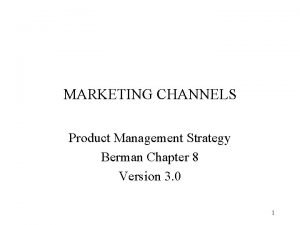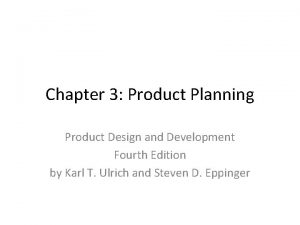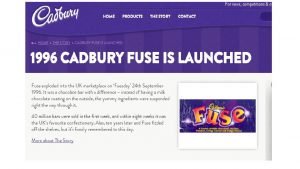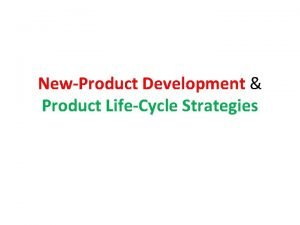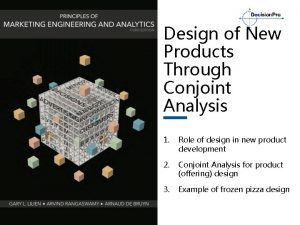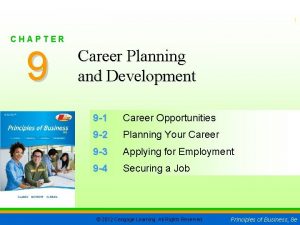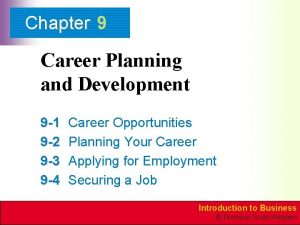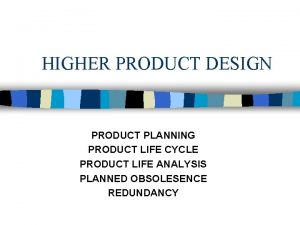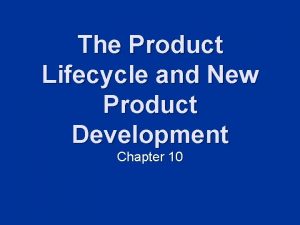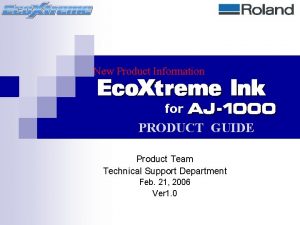Chapter 7 New Product Planning and Development Key




























- Slides: 28


Chapter 7 New Product Planning and Development Key Terms New Product Strategy, Market Penetration, Product Development, Market Development, Diversification, Additional Profits, Increased Growth, Cyclical Stability, New Product Planning, New Product Development Process, Out-rotation, Strategic Risk, Market Risk, Internal Risk, Skunkworks, , Rugby or Relay Approach, Cross-functional Teams, Time to market, Warranty, Guarantee, Product Feature Mc. Graw-Hill/Irwin © 2009 The Mc. Graw-Hill Companies, All Rights Reserved

Additional Facts About New Products • Many new products are failures, ranging from 33 percent to 90 percent, depending on the industry • Sales of new products potentially provide a large boost to the company’s growth rate • Companies vary widely in the effectiveness of their new product programs • A major obstacle to effectively predicting new product demand is limited vision • Common elements appear in the management practices that distinguish the relative degree of efficiency and success between companies Mc. Graw-Hill/Irwin © 2009 The Mc. Graw-Hill Companies, All Rights Reserved

Additional Facts About New Products • Inability to satisfy customer needs can be attributed to three main sources: • • • Inadequacy of upfront intelligence efforts Failure on the part of the company to stick close to what the company does best Inability to provide better value than competing products and technologies Mc. Graw-Hill/Irwin © 2009 The Mc. Graw-Hill Companies, All Rights Reserved

New Product Strategies • New-to-the-world products – Products that are new inventions • New category entries – Products that take the firm into a new category, but are not new to the world • Additions to product lines – Products that are line extensions or flankers to the current markets • Product improvements – Current products made better • Repositioning – Products retargeted for new use or application Mc. Graw-Hill/Irwin © 2009 The Mc. Graw-Hill Companies, All Rights Reserved

New Product Strategies • Developed by H. Igor Ansoff in the form of growth vectors • • Market penetration – Growth direction through increase in market share for present markets Product development – Creating new products to replace existing ones Market development – Finding new customers for existing products Diversification – Developing new products and cultivating new markets Mc. Graw-Hill/Irwin © 2009 The Mc. Graw-Hill Companies, All Rights Reserved

New Product Strategies Organizational Growth Strategies Mc. Graw-Hill/Irwin © 2009 The Mc. Graw-Hill Companies, All Rights Reserved

New Product Strategies • Policy-making criteria on new products should specify • • Working definition of profit concept acceptable to top management Minimum level or floor of profits Availability and cost of capital to develop a new product Specified time period for recuperating operating costs and contributing to profits Mc. Graw-Hill/Irwin © 2009 The Mc. Graw-Hill Companies, All Rights Reserved

Factors Associated with New Product Success Mc. Graw-Hill/Irwin © 2009 The Mc. Graw-Hill Companies, All Rights Reserved

The New Product Development Process Mc. Graw-Hill/Irwin © 2009 The Mc. Graw-Hill Companies, All Rights Reserved

Idea Generation • Every product starts as an idea • Most ideas do not become products • Idea generation – Requires recognizing available idea sources • • Least expensive step in new product development Top-management support – New product development must focus on meeting customer needs Technology push and market pull research activities play an important role Out-rotation – Involves placing employees in positions that require direct contact with customers, competitors, and other key outside groups Mc. Graw-Hill/Irwin © 2009 The Mc. Graw-Hill Companies, All Rights Reserved

Idea Screening • Strategic risk – Risk of not matching the role of a new product with a specific strategic need • Market risk – Risk that a new product won’t meet a market need in a value-added, differentiated way • Internal risk – Risk that a new product won’t be developed within the desired time and budget Mc. Graw-Hill/Irwin © 2009 The Mc. Graw-Hill Companies, All Rights Reserved

Idea Screening • Strategic alliance – A long-term partnership between two organizations designed to accomplish strategic goals of both parties • Potential benefits of strategic alliances include • • • Increased access to technology, funding, and information Market expansion and greater penetration of current markets De-escalated competitive rivalries Mc. Graw-Hill/Irwin © 2009 The Mc. Graw-Hill Companies, All Rights Reserved

Project Planning • Analyze the proposal in terms of production, marketing, financial and competitive factors • Establish a development budget with preliminary marketing and technical research • Create a “rough form” product • Alternative product features and components specified • Create a project plan with estimated costs, capital requirement, and manpower needs • Review the project plan with top management Mc. Graw-Hill/Irwin © 2009 The Mc. Graw-Hill Companies, All Rights Reserved

Project Planning • Two better-known methods for creating and managing project teams include • • Skunkworks – A project team can work in relative privacy away from the rest of the organization Rugby or relay approach – Groups in different areas of the company are simultaneously working on the project • A key component contributing to the success relates to the emphasis placed on creating cross-functional teams early in the development process Mc. Graw-Hill/Irwin © 2009 The Mc. Graw-Hill Companies, All Rights Reserved

Product Development • Upon evaluation, if all expectations are met, consider further research and testing • Produce a finished product and market test it • Development report must spell out in detail • • Results of the studies by the engineering department Required plan design Production facilities design Tooling requirements Marketing test plan Financial program survey Estimated release date Mc. Graw-Hill/Irwin © 2009 The Mc. Graw-Hill Companies, All Rights Reserved

Measurements of New Product Performance Mc. Graw-Hill/Irwin © 2009 The Mc. Graw-Hill Companies, All Rights Reserved

Test Marketing • The main goal is to evaluate and adjust, if necessary, the marketing strategy to be used in the marketing mix • Developers can use interaction with buyers as a foundation for future product development • Throughout the process, findings are being analyzed and forecasts of volume developed • Upon completion of the test market, prepare a final marketing plan in preparation for launch Mc. Graw-Hill/Irwin © 2009 The Mc. Graw-Hill Companies, All Rights Reserved

Commercialization • The firm commits to introducing the product into the marketplace • Heavy emphasis is placed on organizational structure and management talent needed to implement the marketing strategy • Follow-up to eliminate bugs in the design, production costs, quality control, and inventory requirements • Procedures and responsibility for evaluating the success of the new product by comparison with projections are also finalized Mc. Graw-Hill/Irwin © 2009 The Mc. Graw-Hill Companies, All Rights Reserved

Time to Market • Defined as the elapsed time between product definition and marketplace product availability • Well documented that companies that reach the market first with a new product enjoy both profit and market share advantages • Increasingly, companies are bypassing timeconsuming regional test markets, when feasible, in favor of national launches Mc. Graw-Hill/Irwin © 2009 The Mc. Graw-Hill Companies, All Rights Reserved

Quality Level • Warranty – Producer’s statement of what it will do to compensate the buyer if the product is defective or does not work properly • To emphasize high quality, organizations generally offer customers more than implied warranties enforced by the courts • Guarantee – An assurance that the product is as represented and will perform properly • Imply to some buyers that the manufacturer is confident of the new products’ quality Mc. Graw-Hill/Irwin © 2009 The Mc. Graw-Hill Companies, All Rights Reserved

Some Criteria for Determining Perceptions of Quality Mc. Graw-Hill/Irwin © 2009 The Mc. Graw-Hill Companies, All Rights Reserved

New Product Decisions • Product features • • • Fact or particular specification of the product Determined by what it is that the customer wants offered These wants are not created by effective marketers but rather are learned • Product design • • • Can clearly differentiate a new product from competitors Good design can add value to the new product A well-designed product can please a customer without necessarily costing more Mc. Graw-Hill/Irwin © 2009 The Mc. Graw-Hill Companies, All Rights Reserved

New Product Decisions • Product safety • • • Safety is both an ethical and practical issue Ethically, customers should not be harmed by using the product as intended When users are harmed by a product, they may stop buying it, tell others about it, or sue the company • Some products are inherently dangerous and can result in injury to users • It may be so expensive to make them safer that buyers cannot afford to buy them Mc. Graw-Hill/Irwin © 2009 The Mc. Graw-Hill Companies, All Rights Reserved

Causes of New Product Failure • No competitive point of difference, unexpected reactions from competitors, or both • Poor positioning • Poor quality of product • Nondelivery of promised benefits of product • Too little marketing support • Poor perceived price/quality (value) relationship Mc. Graw-Hill/Irwin © 2009 The Mc. Graw-Hill Companies, All Rights Reserved

Causes of New Product Failure • Faulty estimates of market potential and other marketing research mistakes • Faulty estimates of production or marketing costs • Improper channels of distribution selected • Rapid change in the market (economy) after product introduction Mc. Graw-Hill/Irwin © 2009 The Mc. Graw-Hill Companies, All Rights Reserved

Research Considerations • What is the anticipated market demand over time? Are the potential applications for the product restricted? • Can the item be patented? Are there any antitrust problems? • Can the product be sold through present channels and the current sales force? What number of new salespersons will be needed? What additional sales training will be required? • At different volume levels, what will be the unit manufacturing costs? Mc. Graw-Hill/Irwin © 2009 The Mc. Graw-Hill Companies, All Rights Reserved

Research Considerations • What is the most appropriate package to use in terms of color, material, design, and so forth? • What is the estimated return on investment? • What is the appropriate pricing strategy? Mc. Graw-Hill/Irwin © 2009 The Mc. Graw-Hill Companies, All Rights Reserved
 New product development and product life cycle strategies
New product development and product life cycle strategies Product planning and development definition
Product planning and development definition Product planning and development
Product planning and development New product planning and the channel management
New product planning and the channel management Contoh product development
Contoh product development Product planning and development
Product planning and development Product design and development plan
Product design and development plan New product planning process
New product planning process A firm is planning to manufacture a new product
A firm is planning to manufacture a new product A firm is planning to manufacture a new product
A firm is planning to manufacture a new product New product development funnel
New product development funnel Design specification
Design specification Idea development process
Idea development process Tabular wbs
Tabular wbs Me too products examples food
Me too products examples food New product development procedure iso
New product development procedure iso Different phases of edlc in embedded system
Different phases of edlc in embedded system Systematic new product development
Systematic new product development Matt damon
Matt damon Chapter 9 career planning and development
Chapter 9 career planning and development Chapter 9 career planning and development
Chapter 9 career planning and development Chapter 9 career planning and development
Chapter 9 career planning and development Chapter 16 toward a new heaven and a new earth
Chapter 16 toward a new heaven and a new earth Chapter 5 feasibility and business planning answer key
Chapter 5 feasibility and business planning answer key Chapter 5 feasibility and business planning answer key
Chapter 5 feasibility and business planning answer key Chapter 30 product planning worksheet answers
Chapter 30 product planning worksheet answers Most new-product ideas come from chapter 14
Most new-product ideas come from chapter 14 Business model sample
Business model sample Key partners key activities key resources
Key partners key activities key resources



